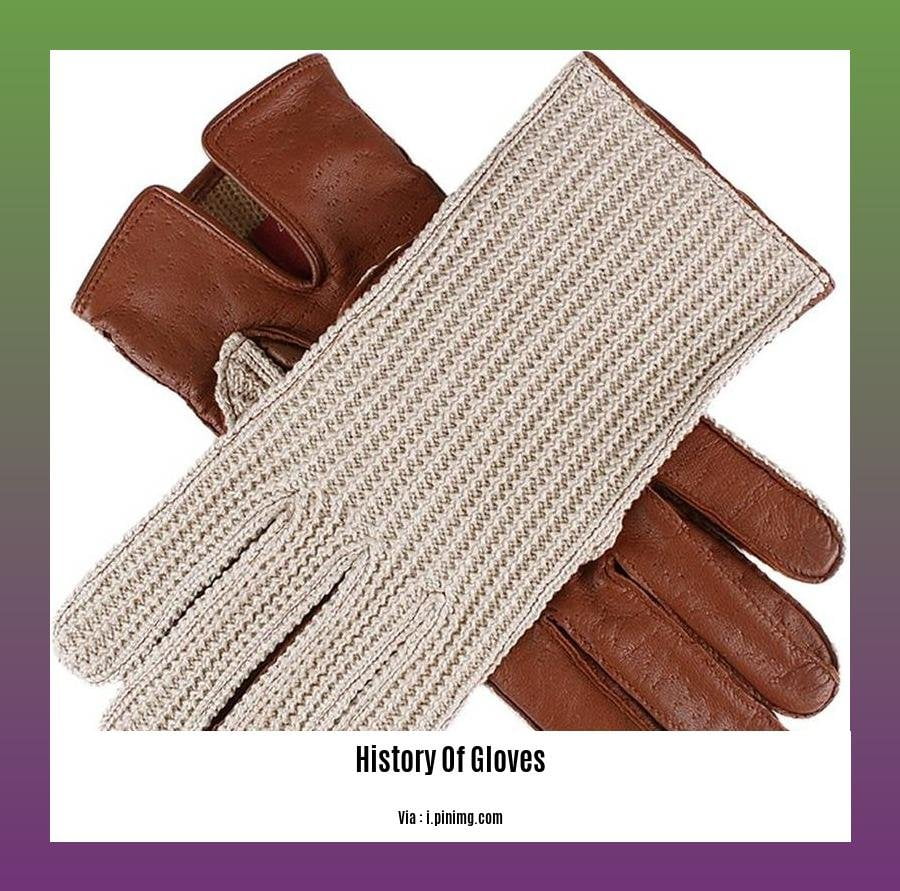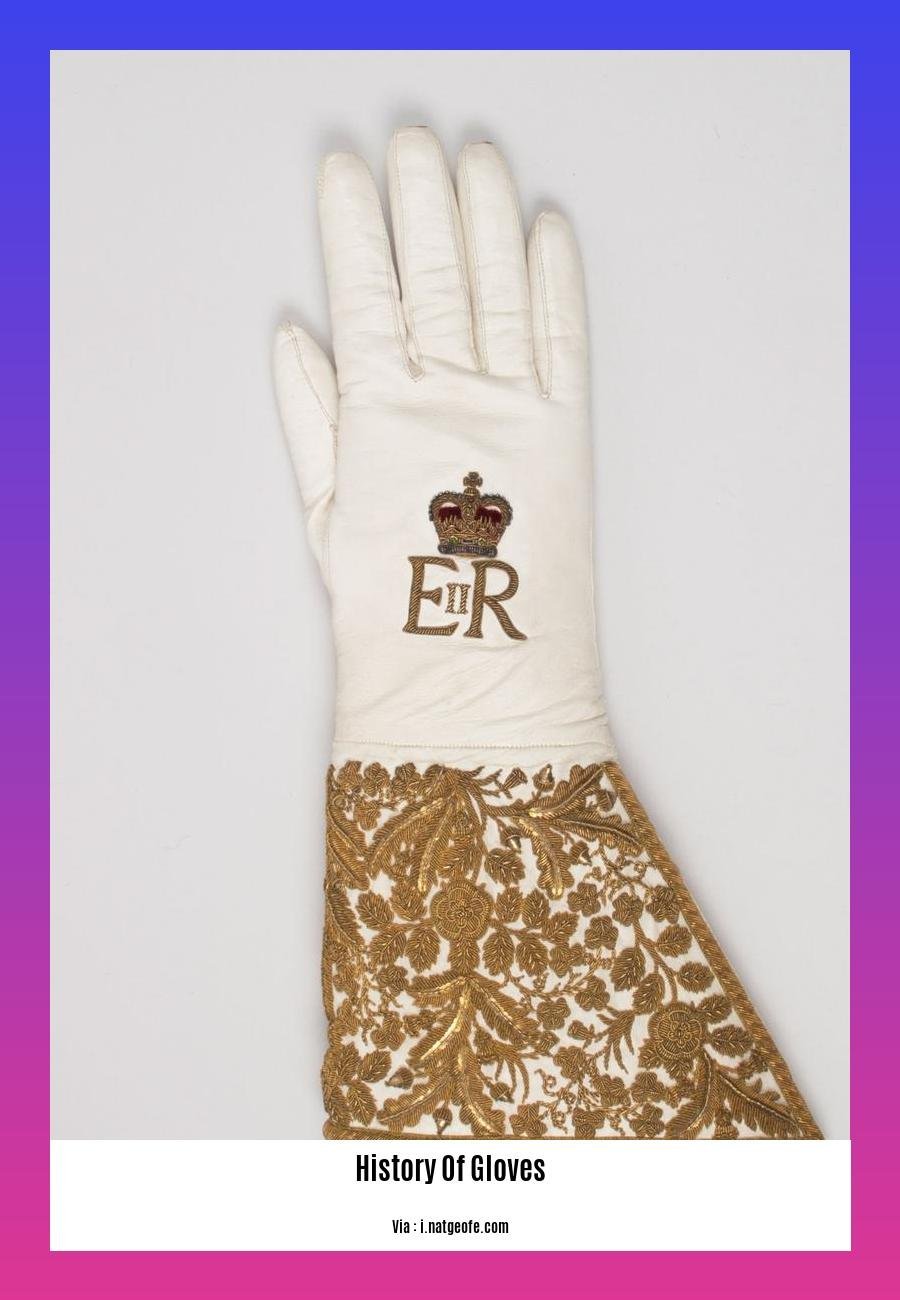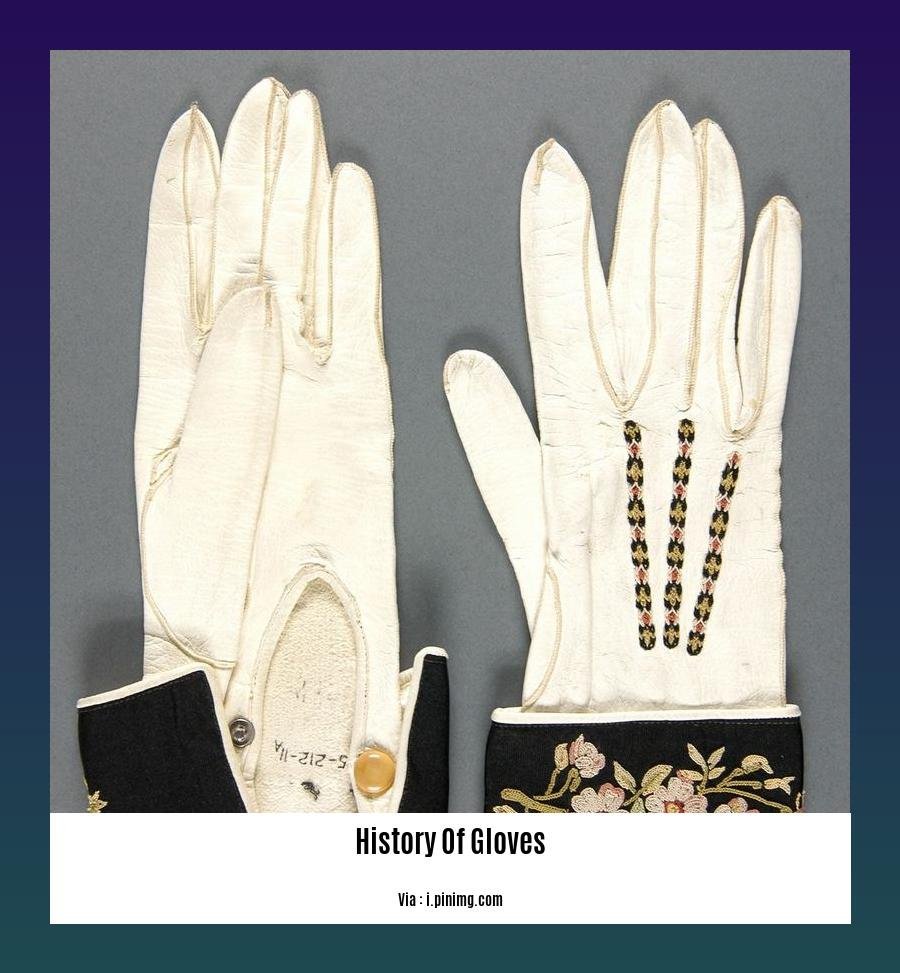Prepare to embark on a fascinating voyage through time and cultures as we delve into the rich history of gloves. From protecting hands in medical settings to adorning them with fashion-forward designs, gloves have played a significant role in shaping human interactions. Discover how surgical gloves revolutionized healthcare, explore the intricate craftsmanship of fashion gloves throughout the ages, and uncover the intriguing stories behind these indispensable accessories in Unveiling the History of Gloves: A Journey Through Time and Cultures.
Key Takeaways:

Gloves have been used for protection and fashion throughout history.
Cave paintings suggest that humans wore simple mittens in the Ice Age.
The oldest existing gloves date back to 1343-1323 B.C. and were found in King Tutankhamun’s Egyptian tomb.
Growing prosperity in the 18th and 19th centuries led to a demand for more gloves in Europe and the Americas.
Gloves were used for both practical purposes, such as protecting hands from heat, cold, or dirt, and for fashion and status.
In the 20th century, gloves continued to be popular, especially for driving and other activities.
History of Gloves: The Hands of Time

We often overlook the significance of humble hand coverings, the gloves, which have accompanied humans throughout history. They have evolved from mere protection against the elements to fashion statements and symbols of societal status. Unraveling the rich tapestry of glove history reveals tales of diverse cultures, technological advancements, and shifting societal norms.
Ancient Roots:
The earliest traces of gloves date back to prehistoric times, with cave paintings depicting individuals clad in simple mittens during the Ice Age. These rudimentary coverings offered protection against the harsh cold. As civilizations flourished, gloves gained cultural significance in ancient Egypt, where they denoted status and symbolized divine favor.
Medieval Elegance:
During the Middle Ages, gloves transformed into intricate accessories, crafted from luxurious materials like silk and adorned with intricate embroidery and embellishments. They became a fashion staple among the nobility, signifying wealth and elegance. The 14th century witnessed the rise of functional work gloves, as artisans and laborers sought protection for their hands while engaging in various trades.
Renaissance Refinement:
The Renaissance ushered in an era of artistic and cultural rebirth, and gloves reflected this newfound elegance. Elaborately decorated gloves, often featuring intricate lace and beadwork, became essential accessories for both men and women. This period also marked the emergence of specialized gloves designed for specific activities like falconry and armor-clad warfare.
Industrial Revolution and Beyond:
The Industrial Revolution witnessed a surge in glove production, thanks to advancements in machinery and manufacturing techniques. Gloves became more accessible, serving practical purposes in various industries, from protective gear in factories to driving gloves for the burgeoning automobile culture.
Fashion and Function:
In the 20th century, gloves remained both a fashion statement and a practical necessity. From sleek leather driving gloves to elegant evening gloves, they complemented various outfits and occasions. Specialized gloves emerged for sports like baseball and golf, enhancing performance and protecting athletes’ hands.
Gloves have transcended their humble origins, becoming cultural symbols steeped in history. They continue to be an integral part of our wardrobe, serving both practical and aesthetic purposes. Whether protecting our hands from the elements, enhancing our style, or signifying societal status, gloves remain a timeless accessory that speaks volumes about our heritage and cultural evolution.
Gloves Through the Ages: A Timeline
| Era | Key Developments |
|---|---|
| Prehistoric | Cave paintings depict individuals wearing simple mittens. |
| Ancient Egypt | Gloves symbolize status and divine favor. |
| Middle Ages | Elaborate gloves crafted from luxurious materials become a fashion staple among the nobility. |
| Renaissance | Gloves become more intricate and specialized, with designs for specific activities like falconry and warfare. |
| Industrial Revolution | Advances in machinery lead to increased glove production, making them more accessible for practical use. |
| 20th Century | Gloves remain a fashion statement and practical necessity, with specialized gloves emerging for sports and various occasions. |
Conclusion:
The history of gloves is a fascinating journey through time and cultures, reflecting human ingenuity, evolving societal norms, and the pursuit of both protection and style. From humble beginnings as protective coverings to sophisticated fashion accessories, gloves continue to play a vital role in our lives, leaving an indelible mark on the tapestry of human history.
If you’re fascinated by the evolution of these humble vehicles, dive into the history of golf carts, from their humble beginnings as modified lawnmowers to the high-tech marvels they have become.
Discover the fascinating journey of greeting cards, from their humble origins as simple handwritten notes to the elaborate and artistic creations we know today.
Lace up your sneakers and embark on a journey through the history of gym shoes, from their humble beginnings as simple canvas shoes to the high-tech marvels of modern sportswear.
History of Surgical Gloves
The history of surgical gloves is a compelling narrative that mirrors the evolution of surgical practices and infection control. In the 19th century, before the advent of sterile surgical techniques, surgeons often operated without gloves. This practice led to a high risk of infection for both the surgeon and the patient. Although the practice was vehemently opposed by many surgeons, Dr. William Halsted, a renowned surgeon at Johns Hopkins Hospital, championed the use of rubber gloves during surgery to protect the surgical team and the patient from infection. In 1889, Halsted and his wife, Caroline Hampton, who was also a nurse, collaborated to develop the first surgical gloves.
Key Moments in the History of Surgical Gloves:
- 1889: Dr. William Halsted introduces the first surgical gloves at Johns Hopkins Hospital.
- 1894: Halsted publishes a paper extolling the virtues of surgical gloves in preventing surgical infections.
- Early 1900s: The use of surgical gloves becomes more widespread as their effectiveness in reducing infection is recognized.
- 1930s: Disposable surgical gloves are developed, making them more accessible and affordable.
- Present: Surgical gloves are an indispensable part of surgical attire, playing a crucial role in infection prevention.
Surgical gloves have undergone several advancements since their inception. Initially made from rubber, they are now commonly made from latex, nitrile, or neoprene. These materials offer improved comfort, dexterity, and protection against a wide range of chemicals and pathogens.
The Impact of Surgical Gloves on Patient Safety:
The introduction of surgical gloves has revolutionized patient safety during surgical procedures. By preventing the transmission of microorganisms between the surgeon’s hands and the patient’s surgical site, they significantly reduce the risk of surgical site infections (SSIs). SSIs are a major complication associated with surgery, leading to increased morbidity, mortality, and healthcare costs.
Key Takeaways:
- 1889: The invention of surgical gloves by Dr. William Halsted.
- Infection Prevention: The primary purpose of surgical gloves is to prevent the transmission of microorganisms between the surgeon and the patient, thereby reducing the risk of surgical site infections.
- Evolution of Materials: Surgical gloves have evolved from rubber to latex, nitrile, and neoprene, offering improved comfort, dexterity, and protection.
- Ubiquitous Use: Surgical gloves are now an indispensable part of surgical attire, routinely used in various surgical specialties.
- Patient Safety: The widespread adoption of surgical gloves has significantly contributed to improving patient safety by reducing the incidence of surgical site infections.
Citations:
FAQ
Q1: When did gloves first appear in history?
A1: Evidence suggests that humans wore simple mittens during the Ice Age, as depicted in cave paintings. The oldest existing gloves, dating back to 1343-1323 B.C., were found in King Tutankhamun’s Egyptian tomb.
Q2: What role did gloves play in fashion history?
A2: Gloves have played a significant role in fashion throughout the centuries. In the 18th and 19th centuries, growing prosperity in Europe and the Americas led to an increased demand for gloves, which were used for both practical purposes and as a symbol of status.
Q3: What was the initial purpose of surgical gloves?
A3: Initially, surgical gloves were introduced to protect operating room staff from infection rather than to protect patients. Their use became more widespread in the early 1900s when their importance in reducing infection was recognized.
Q4: Who invented surgical gloves and when?
A4: The surgical glove was invented in 1889 by William Halsted, a surgeon at Johns Hopkins Hospital. His wife, Caroline Hampton, was the first person to wear the gloves during surgery.
Q5: How did surgical gloves contribute to infection control in surgery?
A5: Surgical gloves play a crucial role in preventing the spread of infection from the surgeon’s hands to the patient. They are now a standard part of surgical attire and have significantly reduced the risk of surgical site infections.
- Senior at What Age: Benefits & Eligibility Guide - March 29, 2025
- Unlocking Senior Benefits: How Old is a Senior? Your Complete Guide - March 29, 2025
- Master Russian Politeness:A Guide to Saying Please - March 29, 2025




![[Phrase Match] Boxing's Glovevolution: An In-Depth Journey Through the History of Boxing Gloves history-of-boxing-gloves_2](https://www.lolaapp.com/wp-content/uploads/2023/12/history-of-boxing-gloves_2-150x150.jpg)











